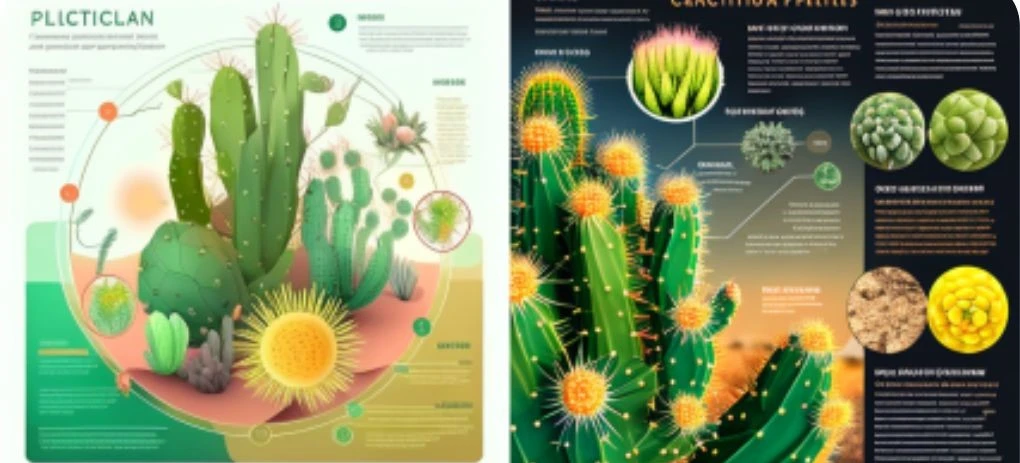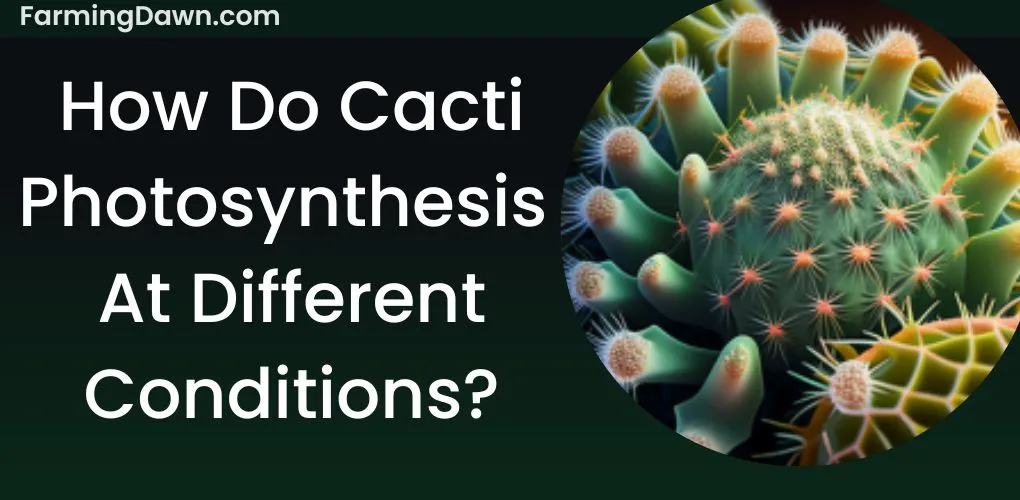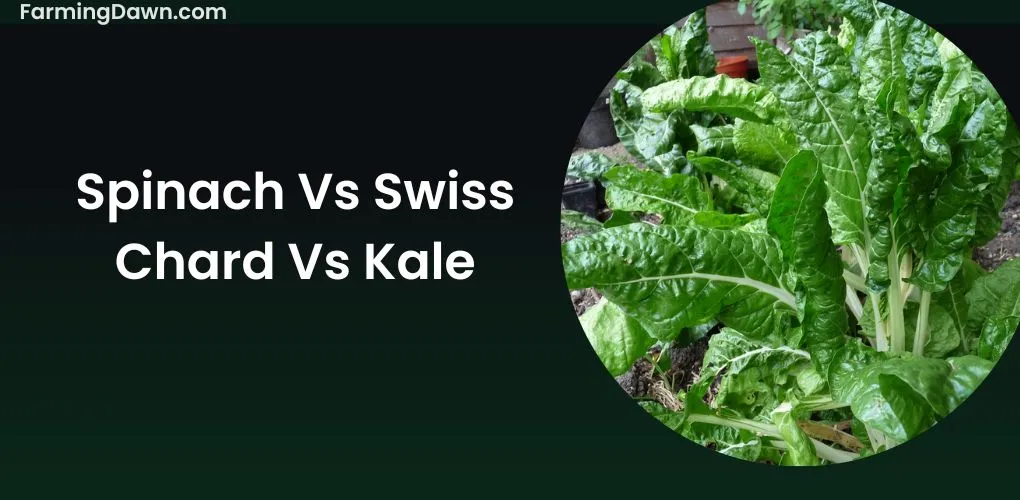How do cacti photosynthesize? These plants are known for their unique appearance and ability to survive in harsh environments, but they also possess a unique method of Photosynthesis that is quite different from others.
These desert dwellers have adapted to their arid surroundings by developing specialized structures and processes that allow them to efficiently capture and use sunlight for energy.
Although it is different from our usual task of gardening, but you will learn a lot it if you give it a read.
Today I will cover different aspects of cacti photosynthesis and how they do it differently. You can read my other post to learn to grow these low-maintenance plants in your garden.
How Do Cacti Photosynthesize?
Cacti are native to deserts, where water is scarce, and the temperature can soar to high levels. To conserve water and endure in such hostile environments, cacti have evolved special physical and physiological adaptations.
One such adaptation is the shape and size of their leaves, which are reduced to spines or, in some cases, completely absent.
This lessens the amount of surface exposed to the sun, reducing water loss through transpiration.
Chlorophyll, the pigment in chloroplasts that absorbs light, uses light energy during Photosynthesis. Then, using this energy, glucose and oxygen are produced from carbon dioxide and water.
The stem of the cactus serves as a “photosynthetic factory,” generating glucose for the plant’s energy requirements and storage.
How does Photosynthesis Work?
Plants, algae, and some microorganisms transform light energy into chemical energy from organic compounds through a process called photosynthesis.
Chlorophyll, the pigment responsible for the green hue of plants, absorbs light energy during Photosynthesis, which is subsequently used to change carbon dioxide and water into glucose (sugar) and oxygen.
The enzyme RuBisCO (ribulose-1,5-bisphosphate carboxylase/oxygenase) combines carbon dioxide with RuBP (ribulose-1,5-bisphosphate) to generate a new molecule and releases oxygen as a byproduct, aids in this chemical reaction.
The plant can either use the glucose produced immediately for energy or store it for later use. In a nutshell, Photosynthesis, which gives plants energy and, in turn, energy for the entire food chain, is the basis of life as we know it.
Why Cacti Perform Photosynthesis Differently?
Unlike most plants that perform Photosynthesis in their leaves, cacti perform this process in their stems.
As a result, they can save water and lessen transpiration, or the loss of water through leaves, which is an important adaptation in arid regions.
To maximize their capacity to photosynthesize in the harsh desert sun, cacti have also developed particular adaptations to effectively capture light, such as flattened stems, shallow ribbing, and colored pigments.
Due to their adaptations to their particular environment, cacti undertake Photosynthesis in a manner that is distinct from that of most plants.
How Cacti Hold Their Breath During The Day?
During the day, when temperatures are high, and evaporation rates are at their peak, cacti can slow down their transpiration process and “hold their breath”.
To do this, they close their stomata, small pores on their leaves that regulate how much water and gas are exchanged with the environment.
Cacti can maintain the valuable moisture they have collected and thrive in their dry environment by minimizing the amount of water lost through transpiration.
Cacti are among the hardiest and most adaptable plants in the world thanks to this adaptation and their capacity to retain water in their thick stems.
How do Cacti Photosynthesize at Night?
Cacti open their stomata, or tiny pores on their leaves, during the day to take in carbon dioxide and release oxygen.
However, cacti continue to photosynthesize at night when the stomata are shut to preserve water by utilizing the sunlight’s stored energy.
How do Cacti Photosynthesize at Night using Crassulacean Acid Metabolism (CAM)
The Crassulacean Acid Metabolism (CAM) process used by cacti is distinct from the photosynthetic process employed by most plants.
Cacti in CAM open their stomata at night to absorb carbon dioxide and store it as organic acids in their cells.
The cacti release the carbon dioxide that has been stored and utilize it for Photosynthesis throughout the day when the stomata are closed. They can still photosynthesize while conserving water during the warmest part of the day.

How Crassulacean Acid Metabolism (CAM) Works
The ability of plants to conserve water by opening their stomata at night and closing them during the day is known as crassulacean acid metabolism (CAM).
This process entails the storage of CO2 as organic acids, primarily malic acid, in the chloroplasts throughout the night when the stomata are open and the subsequent release of the stored CO2 to be utilized in Photosynthesis during the day when the stomata are closed.
CAM plants can flourish in dry climates and times of water stress because they have reduced transpirational water loss.
These plants benefit from CAM’s mechanism by maintaining a high level of CO2 concentration in their chloroplasts, which makes the photosynthetic process more effective.
How do Cacti Photosynthesize at Night using Chlorophyll
Chlorophyll, the pigment responsible for absorbing light energy, is another element that enables cacti to photosynthesize at night.
Chlorophyll is abundant in cacti, allowing them to absorb and retain light energy even when it is in little supply. Nighttime Photosynthesis can subsequently be carried out using this energy.
How do Cacti Photosynthesize without leaves?
The majority of plants have leaves, special organs created for Photosynthesis only. However, cacti have been designed to conserve water by minimizing the surface area exposed to the environment.
Cacti are plants without leaves; instead, they have thick, fleshy stems that store water and act as a site for Photosynthesis.
Cacti can do Photosynthesis similarly to leaves because of their green stems thickly coated in Chlorophyll. To increase light absorption, cactus stems are designed with maximum available surface area.
Cacti also have a peculiar structure called an Areole, a small, cushion-like structure holding spines, buds, and flowers. In order to make up for the absence of leaves, Areoles may be used, which are also photosynthetic sites.
How do cacti Photosynthesize without leaves using Ribbed Structure
Cacti’s ribbed Structure is another adaptation that allows them to photosynthesize efficiently. Ribs on cactus stem to increase the surface area of the stem and also offer cosmetic attractiveness.
The cactus’ increased surface area allows it to absorb more light and perform Photosynthesis more efficiently.
How do Cacti Photosynthesize without Losing Moisture?
Cacti use a different method of Photosynthesis that aids in water conservation.
Cacti feature unique structures called chlorophyll-containing cells situated immediately below the plant’s surface, in contrast to other plants that depend on mesophyll cells.
These cells can directly absorb carbon dioxide from exposure to the air. These plants can avoid water loss by doing this instead of using their leaves to absorb water, which would result in water loss.
In addition to having cells that carry Chlorophyll, cacti also have thick, fleshy stems that can store a lot of water.
Cacti may continue to photosynthesize using the stored water, enabling them to withstand protracted shortages of water. They also have a covering of spines or hairs on their stems, which aid in retaining moisture and lowering evaporation.
How do Cacti Photosynthesize? Conclusion
This post was different from our routine genre, but knowing how cactus photosynthesize under various environmental situations can teach us about life’s adaptability and motivate us to protect these priceless species.
I hope you liked this article. Leave a comment. Thank you!
Each plant has its photosynthesis mechanism. Read my other articles to learn more:






